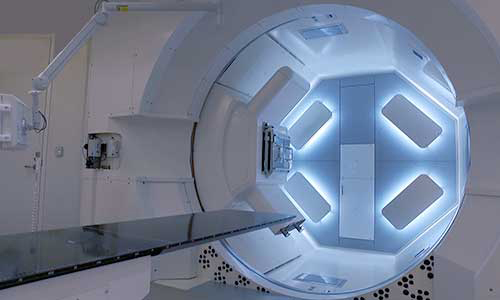Soft Tissue Sarcomas
Soft tissue sarcomas originate in the soft tissues of the body and are most commonly found in the arms, legs, chest or abdomen. Soft tissue tumors can occur in children and adults.
Soft Tissue Sarcomas in Children
Rhabdomyosarcoma is the most common type of soft tissue sarcoma in children, accounting for more than half of pediatric soft tissue sarcoma cases. Rhabdomyosarcomas occur in the muscles, primarily in the head and neck region. There is a slightly higher incidence of rhabdomyosarcoma among boys. In addition, there is a higher incidence of the disease among children exposed to chemicals and chemical pollution. Also, there’s a higher incidence of rhabdomyosarcoma if a child’s father smokes cigarettes.
Rhabdomyosarcomas are classified into two main types:
-
Embryonal. most frequently seen in the head and neck area, bladder, vagina and prostate and testicles
-
Alveolar. a more aggressive form of the disease most often found in the large muscles of the arms, legs, and trunk
Soft Tissue Sarcomas in Adults
In adults, sarcomas can occur in soft tissues throughout the body. However, most of them are found in the arms and legs. The risk of metastasis (spreading) is higher in cases of soft tissue sarcomas in adults, partly because their soft tissue tumors commonly develop in the arms and legs and can more easily spread to the lymph nodes. For example, synovial sarcoma, rhabdomyosarcoma, and epithelioid sarcoma are soft tissue sarcomas that can spread to the lymph nodes.
Other Types of Soft Tissue Sarcomas
Other types of soft tissue tumors include the following:
-
Abdominal sarcoma
-
Alveolar soft part sarcoma
-
Angiosarcoma
-
Clear cell sarcoma
-
Desmoid sarcoma
-
Desmoplastic small round cell tumor
-
Extraskeletal chondrosarcoma
-
Extraskeletal Ewing sarcoma
-
Extraskeletal osteosarcoma
-
Fibrosarcoma
-
Ganglioneuroblastoma
-
Gastrointestinal stromal tumor
-
Hemangiopericytoma
-
Leiomyosarcoma
-
Lymphangiosarcomas
-
Malignant fibrous histiocytoma
-
Malignant peripheral nerve sheath tumor
-
Malignant schwannoma
-
Neuroblastoma
-
Neurofibrosarcoma
-
Rhabdomyosarcoma (types: embryonal, embryonal botryoid, embryonal alveolar, pleomorphic and anaplastic)
-
Synovial cell sarcomas
-
Undifferentiated pleomorphic high-grade sarcoma
Soft Tissue Sarcomas | FAQ with Dr. Adam Levin
Soft tissue sarcomas can occur in many parts of the body and may affect different soft tissues, such as muscle or fat. Orthopaedic oncologist Adam Levin discusses the most common types of soft tissue sarcomas and how they are diagnosed and treated.
Soft Tissue Sarcoma Treatment
Radiation Therapy for Soft Tissue Sarcomas
Radiation therapy uses high-energy particles or waves to kill cancer cells in patients with soft tissue sarcoma.
The following radiation treatment strategies may be used to treat soft tissue sarcoma:
- Use radiation before surgery to shrink the tumor, making the procedure easier
- Administer radiation after surgery to destroy any remaining cancer cells
- Administer radiation as the primary soft tissue sarcoma treatment if the patient isn’t healthy enough to have surgery
- Use radiation as a palliative treatment to manage symptoms when the sarcoma has spread to other areas of the body
Types of Radiation Therapy for Soft Tissue Sarcomas
Radiation oncologists may use the following radiation therapies to treat soft tissue sarcoma:
- External beam radiation therapy. This technique delivers beams of high-energy X-rays from an external source to the tumor site. Intensity-modulated radiation therapy (IMRT) is a type of external beam radiation that allows the physician to deliver targeted radiation doses to the tumor site while sparing surrounding organs and tissue.
- Intraoperative radiation therapy (IORT). This provides an intensive, targeted dose of radiation to the tumor site after the tumor is surgically removed but before the wound is closed, allowing the radiation to reach the cancer without traveling through healthy tissue. Additional radiation treatments may be used after surgery.
- Brachytherapy. This targeted radiation treatment is delivered via radioactive pellets (seeds) that are placed directly in or near the tumor. For patients with soft tissue sarcoma, the seeds are inserted into catheters that have been placed in the patient during surgery. High-dose-rate brachytherapy involves a significant amount of radiation over a short period of time. Low-dose-rate brachytherapy delivers radiation over an extended treatment period.
- Image-guided radiation therapy (IGRT). By using frequent imaging to capture images of the cancer site, this technique allows the radiation oncologist to deliver radiation with enhanced precision and accuracy. The radiation oncologist can create and view images of the tumor site before and during the radiation session. IGRT is especially useful for treating cancers that are located near highly sensitive structures or organs. It may also be helpful in treating tumors that are likely to move during treatment sessions or between treatments.
- Stereotactic body radiation therapy (SBRT). This radiation treatment uses advanced imaging techniques to deliver high doses of radiation that precisely target the tumor while minimizing exposure to nearby healthy tissue. Before the treatment is delivered, the radiation oncologist and treatment team use three-dimensional imaging to determine the exact coordinates of the tumor. SBRT can be used to treat very small, well-defined tumors in patients who aren’t qualified for surgery.
The Johns Hopkins Proton Therapy Center

Proton therapy is used to treat certain tumors in children and adults. Our treatment center, located at Sibley Memorial Hospital in Washington, D.C., combines advanced proton therapy technology, the latest research and caring specialists.






